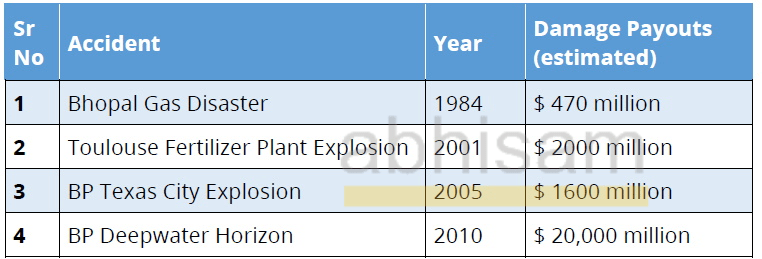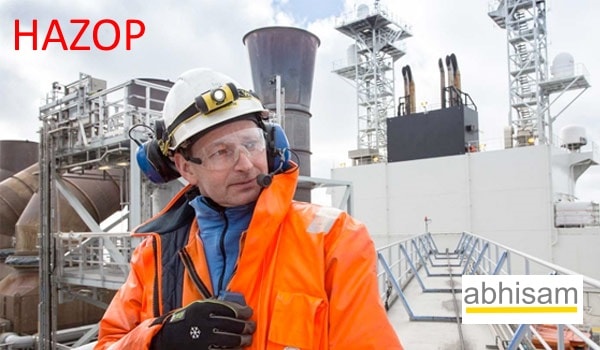How Process Safety Management reduces Enterprise Risk
Free Abhisam White Paper

Executive Summary:
Process Safety Management (PSM for short) is one of the most important functions of the management of any of the industries that are in the Oil & Gas, Chemical, Petrochemical, Fossil Fuel based Power Generation, Pharmaceutical and similar domains.
This is because these industries generally handle a lot of hazardous materials, that have the risk of fire, explosion, damage to own assets, adverse effects on people, toxic leaks and environmental destruction.
A failure to adhere to best practices can put the entire company’s existence in jeopardy, not just the unit where an accident took place. This white paper examines how proper PSM can lead to a secure future.
What is Enterprise Risk?
In popular literature available online, most enterprise risk is mainly implied as being either financial risk due to incompetent or malicious management, supply chain related risk or legal compliance risk. While these may hold true for financial institutions like banks, these are not the only things to look out for if you are running an oil company or a chemical manufacturing company. An important risk in these enterprises is the possibility of accidents that can damage assets, kill or injure people (not just within the perimeter of the facility but also outside) and even cause lasting environmental damage. And no, the only way to hedge against these risks is not by just buying more insurance, but by having a pro-active Process Safety Management program.
This one factor will cut down the total risk drastically. So how do we do this? Read on below.
Increasing Risk Profiles
The process industries operate in a high risk environment, especially these days. If you compare the scene about 30 years ago, then one realizes three things immediately.
- The amount of hazardous materials handled at each site was much less in earlier times than today, due to the tendency to have much larger plants (to reduce costs and increase competitiveness).
- Consequently, due to the fact above, an accident today is much more severe and can cause much more damage and destruction.
- Due to increased public awareness and the tendency of the authorities to be seen to be doing more, the amount of fines and punitive damages that are awarded are multiple times higher than earlier.
Costs of accidents
There is a famous saying among Safety professionals that goes like this “If you think safety is expensive, just have an accident- you’ll realize what’s really more expensive”
If one sees the larger accidents in the process industries in the past few years, one can easily see this in action. Take a look at the table below. Note that the damages indicated are just the payouts (fines, court awards, punitive actions, etc). The human and environmental costs have not been considered, nor the costs of brand damage and goodwill. Even without considering them, the trend is clearly seen- a large increase in the scale of the payouts.

Taking a look at the above clearly shows that it will be much cheaper for a company to have proper process safety management in place rather than get whiplashed by the tsunami of costs that can occur, following an accident.
Process Safety Management (PSM) versus Occupational Safety
There is a tendency amongst top management (especially those who do not have a technical background with hands on manufacturing experience), to conflate Process Safety Management with Occupational Safety Management. Both are completely different. Occupational Safety is all about protecting people via wearing of Personal Protective Equipment (PPE for short) such as Helmets, Gloves, Goggles and safety shoes. It is also about preventing falls and trips, back injuries and so on. On the other hand, Process Safety Management is about making the process itself safer. Thus it includes studying the existing production or manufacturing process using Risk Assessment tools such as HAZOP, determination of Risk Reduction factors using Safety Integrity Level (SIL Studies) and then reducing them, studying the environmental impacts of process changes, following a Management of Change (MoC) procedure during any changes to equipment or parameter setpoints or process modifications. It is also about designing and maintaining a proper alarm and safety interlock system (including Safety Instrumented Systems/ Emergency Shutdown Systems / Safety Shutdown Systems and the like).
More about PSM
The US Occupational Safety and Health Administration (OSHA) has published a comprehensive standard (OSHA 1910.119) on PSM that includes the following 14 elements:
The standard 29 CFR 1910.119 defines all 14 elements of process safety management plan, which are as under.
- Process Safety Information
- Process Hazard Analysis
- Operating Procedures
- Training
- Contractors
- Mechanical Integrity
- Hot Work
- Management of Change
- Incident Investigation
- Compliance Audits
- Trade Secrets
- Employee Participation
- Pre-startup Safety Review
- Emergency Planning and Response
Note that every element above has several subsections like for example Process Hazard Analysis talks about different ways of doing this such as by carrying out a HAZOP. Paying attention to all these 14 elements is important if you wish to comply.
As you can see, this is a far bigger scope than just Occupational Safety.
Why is PSM more impactful than Occupational Safety
A bad PSM can cause a disaster that can take down the entire company itself in flames (literally), not just the factory or site that had the accident. On the other hand, gaps in occupational safety management may impact individual worker’s safety, not the entire company’s existence. Don’t get us wrong, we are not saying that Occupational Safety is less important, we are merely pointing out that focusing on only occupational safety (at the cost of process safety) can have disastrous consequences. For example, compare the possible effect of not carrying out a HAZOP on a process that handles dangerous chemicals versus not wearing a helmet while walking in the area that processes these. Both can have bad consequences, but the former will have a larger (and worse) impact.
How to start doing serious PSM?
The first step in becoming serious about a subject is by learning about it. Not just the top management, but the engineers, operators and technicians, line supervisors have to be knowledgeable about Process Safety. It is one of the most important parts of a Process Safety Management program, since only proper training can fill the knowledge gaps in the workforce that is responsible for the actual implementation of process safety. This can include topics such as HAZOP Training, Chemical Warehouse safety training or training on Hazardous Areas for example. Or it can be a comprehensive Process Safety and Environment Management training program (Abhisam offers this in a blended learning format). For more details please see here.
Note that the most cost effective ways of ensuring that all employees are trained in Process Safety, is by implementing an e-learning strategy that can not just train, but also evaluate employees on their existing process safety knowledge, fill in the gaps and keep their knowledge current and up to date. Abhisam’s XPRTUs alongwith the Abhisam Competency Assessment Engine can do this easily for your company. You can be assured that this strategy is the most cost effective today, as compared to running traditional classroom training programs or by just playing some old grainy video tapes in the company cafeteria from time to time!
Reducing Enterprise Risk
Since one of the biggest risks to the enterprise that operates an oil refinery or a chemical plant, is the risk of a process accident, the implementation and maintenance of a good PSM can reduce the possibility of accidents, manifold. Note that the other risks, such as Financial, Supply Chain, etc have to be mitigated separately. However this assumes that these risks are usually always factored by the top management.
Learn HAZOP & get certified
In this HAZOP Training course, learn how to carry out a HAZOP in detail. Animations, simulations, real life situations, case studies and usable worksheets make this a great learning experience. This is the only course that covers CHAZOP as well as Human Factors HAZOP.
Become a HAZOP Leader
Qualify as a HAZOP Leader (HAZOP Chairman) when you take this online course from Abhisam.
Fully self paced, the course consists of several online modules, an assignment and an associated exam.
Contact Us by filling the form below OR call us OR email


